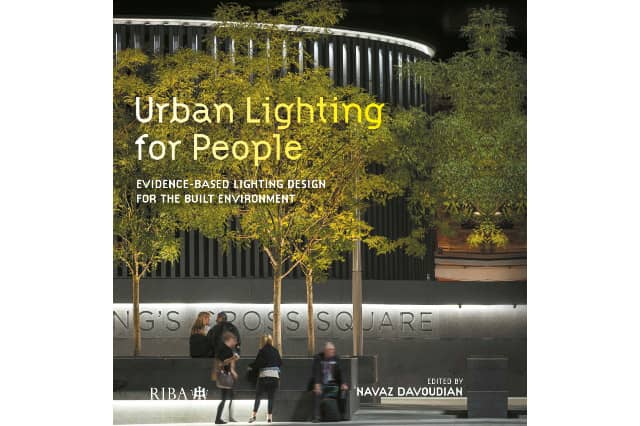
www.buildingsandcities.org/insights/reviews/urban-lighting-for-people-evidence-based-lighting-design-review.html
Urban Lighting for People: Evidence-Based Lighting Design for the Built Environment

Edited by Navaz Davoudian. Routledge, 2019, ISBN: 9781859468210
Marilyne Andersen (Ecole Polytechnique Fédérale de Lausanne - EFPL) reviews this book which offers insight into the different factors that shape successful night-lighting in urban environments, including: the role of light in public spaces; occupant acceptance; and luminence distribution.
This book offers a multifaceted perspective on the importance and challenges of lighting cities for people. Through a rigorous combination of theory and practice-based approaches, it provides the reader with well-articulated principles, experiment-based learnings and both lucidly and comprehensively evaluated examples that lie behind a successfully night-lit urban environment.
Without suggesting a paradigm
shift in approaching urban lighting, the book brings a new understanding about
the multi-dimensional nature of urban lighting by taking an encompassing
perspective, notably by addressing the psychological, behavioral and social
influence that urban lighting has for the people that experience it.
The key question that
the book tries to address pertains to the transition from research to design
and practice. The approach adopted starts by setting principles and stating the
problem, and moves forward by diving into the specifics of representative case
studies. Its novelty thus relies on investigating the numerous factors that
play a role in a successful night-lighting design and go well beyond lighting
technology questions, without ever overwhelming the reader with the underlying
complexity of their interactions. Instead, it offers a range of pragmatic means
to establish priorities in this process.
The Introduction
section, written by the editor, offers a broad and insightful dive into the
topic of the book, namely urban lighting design. By addressing questions of the
meaning and pertinence of evidence-based design in this context, and connecting
it to more fundamental issues of knowledge, of science and of practice, it is
very efficient in engaging a wide audience of readers -researchers,
practitioners, planners and policy makers - into the topic by connecting the
many dimensions of urban lighting to one another, from social and behavioral
considerations to efficacy and policy-oriented ones, while offering specific
and tangible information about them, rather than generalities.
The content presented in the subsequent chapters, especially in Parts I and II, is able to maintain a comparable level of pertinence. Taking different perspectives, these chapters offer various entry points to the inherent multi-disciplinarity embedded in urban lighting design as it requires expertise from different fields like environmental psychology, social science, urban planning, landscape and architectural design and of course photometry and lighting technology. Tackling questions as broad as the meaning and relevance of the social dimension, which encompasses questions of generational specificities but also of community-level versus individual expectations for instance, and as practical and useful as methodological principles behind collaborating across the fields mentioned above, the book is a journey into the importance, relevance and challenges of making cities lit for their users, particularly at night. It thus speaks as much to designers and planners as it does to economists or researchers, as long as they share an interest in understanding more about what lies behind decisions made for urban lighting - or what should. Such chapters tend to be quite broad in scope while others can be extremely focused and include quite technical, research-based parts - like chapter 3 and 4 on bringing in the urban lighting needs of the elderly. In these chapters, the specific needs of elderly people are presented and discussed at various levels, such as how the ageing of the eye or the adaptation of behavior and fears when we get older does and should influence how we design urban lighting at night. It also warns us about the danger of simplistic solutions that would not account for these changes and offers clear recommendations towards more adapted lighting principles.
The different topics
are introduced elegantly and raise the reader's interest early on, while the
statements made are backed up by either research, experience or existing
literature in a convincing way. Thanks to this approach, the book can be read
by the general public interested in the subject or curious to better understand
why certain urban environments are lit in certain ways, as much as to policy
makers, who may want to come up with a well-informed strategy for future urban
developments. The principles and lessons
learnt are amply and nicely supported by concrete examples of lighting design
projects not only to which they apply, but also in which their limitations and
challenges can be revealed. Some of these projects, like the Whitecross Estate
or the Narrow Way in chapter 1, have a dedicated focus on the acceptability of
projects by their intended occupants, with very interesting lessons learned
regarding the difference in perception between designers and users. The Granary
Square project, on the other hand, is used in chapter 2 to discuss the need to
establish a robust collaborative framework within the highly diverse project
team. This project is referred to again in chapter 6, but from a very different
perspective and scale, namely luminance distribution in one's field of view. As
further discussed also in chapter 5, the reader gets to appreciate the role of
light in shaping public spaces and to better understand our response to it, by
diving into quite specific concepts such as the visual saliency resulting from
a given lighting scenario and its role in addressing wayfinding issues. As
these examples are quite diverse, they cover a relevant range of contexts and of
challenges typically faced in lighting urban environments.
What is particularly
notable in the Part I and II chapters is how carefully the authors sought to
keep an objective standpoint, with ample documentation based on research or on
experience gained from professional practice: the latter - whether research or
practice-based - oftentimes included their own work but was expressed in a
neutral way, without ever highlighting their own accomplishments over the
message to be remembered overall. This aspect distinguishes these two parts
from Part III which is dedicated to the presentation of a selection of projects
from the Arup Lighting group in chapter 7, used as successful lighting design examples
to help further illustrate what was learned in Parts I & II. In this last
chapter, a rich diversity of lighting design projects is offered, together with
their evaluation in hindsight. The authors propose different points of view for
their case study analyses, so as to exemplify the different concepts that can
lie behind a given lighting design (e.g. connection versus discovery), to illustrate
the influence of context or discuss the confrontation between experience and
compliance taken too literally, as well as the range of opportunities offered
by emerging technology.
The last section of each
of the chapters, entitled 'Key learning points', represents another remarkable
component of this book, that very effectively makes the information presented accessible.
It does this by providing a clear and useful synthesis of the most memorable
lessons to learn which, rather than becoming high level summaries, instead lists
some carefully selected, insightful and specific messages that pertain to the
chapter they close. This makes it easy for both experts and non-experts to know
which take-home messages to focus on depending on what drove their interest in
the topic in the first place, which further helps in reaching out to the book's
audience.
Latest Peer-Reviewed Journal Content
Designing for pro-environmental behaviour change: the aspiration–reality gap
J Simpson & J Uttley
Lifetimes of demolished buildings in US and European cities
J Berglund-Brown, I Dobie, J Hewitt, C De Wolf & J Ochsendorf
Expanding the framework of urban living labs using grassroots methods
T Ahmed, I Delsante & L Migliavacca
Youth engagement in urban living labs: tools, methods and pedagogies
N Charalambous, C Panayi, C Mady, T Augustinčić & D Berc
Co-creating urban transformation: a stakeholder analysis for Germany’s heat transition
P Heger, C Bieber, M Hendawy & A Shooshtari
Placemaking living lab: creating resilient social and spatial infrastructures
M Dodd, N Madabhushi & R Lees
Church pipe organs: historical tuning records as indoor environmental evidence
B Bingley, A Knight & Y Xing
A framework for 1.5°C-aligned GHG budgets in architecture
G Betti, I Spaar, D Bachmann, A Jerosch-Herold, E Kühner, R Yang, K Avhad & S Sinning
Net zero retrofit of the building stock [editorial]
D Godoy-Shimizu & P Steadman
Co-learning in living labs: nurturing civic agency and resilience
A Belfield
The importance of multi-roles and code-switching in living labs
H Noller & A Tarik
Researchers’ shifting roles in living labs for knowledge co-production
C-C Dobre & G Faldi
Increasing civic resilience in urban living labs: city authorities’ roles
E Alatalo, M Laine & M Kyrönviita
Co-curation as civic practice in community engagement
Z Li, M Sunikka-Blank, R Purohit & F Samuel
Preserving buildings: emission reductions from circular economy strategies in Austria
N Alaux, V Kulmer, J Vogel & A Passer
Urban living labs: relationality between institutions and local circularity
P Palo, M Adelfio, J Lundin & E Brandão
Living labs: epistemic modelling, temporariness and land value
J Clossick, T Khonsari & U Steven
Co-creating interventions to prevent mosquito-borne disease transmission in hospitals
O Sloan Wood, E Lupenza, D M Agnello, J B Knudsen, M Msellem, K L Schiøler & F Saleh
Circularity at the neighbourhood scale: co-creative living lab lessons
J Honsa, A Versele, T Van de Kerckhove & C Piccardo
Positive energy districts and energy communities: how living labs create value
E Malakhatka, O Shafqat, A Sandoff & L Thuvander
Built environment governance and professionalism: the end of laissez-faire (again)
S Foxell
Co-creating justice in housing energy transitions through energy living labs
D Ricci, C Leiwakabessy, S van Wieringen, P de Koning & T Konstantinou
HVAC characterisation of existing Canadian buildings for decarbonisation retrofit identification
J Adebisi & J J McArthur
Simulation and the building performance gap [editorial]
M Donn
Developing criteria for effective building-sector commitments in nationally determined contributions
P Graham, K McFarlane & M Taheri
Join Our Community

The most important part of any journal is our people – readers, authors, reviewers, editorial board members and editors. You are cordially invited to join our community by joining our mailing list. We send out occasional emails about the journal – calls for papers, special issues, events and more.
We will not share your email with third parties. Read more



Latest Commentaries
COP30 Report
Matti Kuittinen (Aalto University) reflects on his experience of attending the 2025 UN Conference of the Parties in Belém, Brazil. The roadmaps and commitments failed to deliver the objectives of the 2025 Paris Agreement. However, 2 countries - Japan and Senegal - announced they are creating roadmaps to decarbonise their buildings. An international group of government ministers put housing on the agenda - specifying the need for reduced carbon and energy use along with affordability, quality and climate resilience.
Building-Related Research: New Context, New Challenges
Raymond J. Cole (University of British Columbia) reflects on the key challenges raised in the 34 commissioned essays for Buildings & Cities 5th anniversary. Not only are key research issues identified, but the consequences of changing contexts for conducting research and tailoring its influence on society are highlighted as key areas of action.